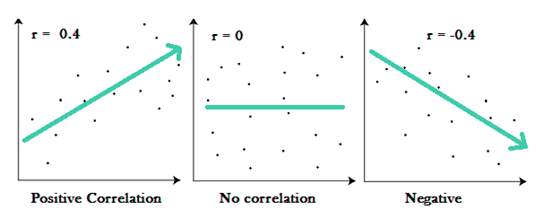Correlation is a statistical measure of the strength and direction of a relationship between two variables. It helps to describe the linear relationship between two variables, indicating how one variable changes as the other changes.
Correlation can range from -1 to +1, where -1 indicates a perfect negative correlation (as one variable increases, the other decreases) and +1 indicates a perfect positive correlation (as one variable increases, so does the other).
A correlation that is close to zero suggests that there is no discernible linear relationship between two variables. Correlation can help in understanding if there are any causative relationships between variables.
In this case, it would help determine whether or not an increase or decrease in one variable has any impact on the value of another variable. For instance, if you find that there is a strong positive correlation between temperature and ice cream sales, you might infer that higher temperatures lead people to buy more ice cream.
In addition to evaluating the strength and direction of relationships between two variables, correlation can be used to compare sets of data with different means and standard deviations. In this way, it can provide information about whether data points that are far away from each other on different scales still have statistically similar values relative to their respective scales.
Practical Applications of Correlation
Correlation also has practical applications across many fields including economics, medicine, psychology and engineering. In economics, for example, economists commonly use correlation when studying how stock prices move in relation to each other over time. In medicine, researchers often use correlations to detect patterns in patient vital signs or diagnoses which may indicate future health risks or issues with treatment plans.
Similarly in psychology, correlations can be used to identify associations between personality traits and behavior which could provide insights into human behavior. Finally in engineering fields such as robotics or automation technologies where machine learning algorithms are widely used for decision making tasks; correlations can be used for discovering patterns which may indicate certain types of faults or malfunctions occur with certain combinations of input parameters. mCorrelation analysis is a useful tool for determining the relationship between two variables.
Advantages and Disadvantages
One of the primary advantages of using correlation is that it can help to identify patterns or trends that may not be immediately obvious. By examining the correlation coefficient between two variables, researchers can gain insight into the strength and direction of their relationship.
Another advantage of correlation analysis is that it can help to test hypotheses. For example, a researcher may hypothesize that there is a positive correlation between time spent studying and academic performance. By examining the data using correlation analysis, this hypothesis can be tested and either confirmed or rejected.
Despite its many benefits, there are also some disadvantages to using correlation analysis. One of the main limitations of correlation is that it only examines the relationship between two variables. This means that other factors that may be influencing the relationship are not taken into account. For example, if there is a correlation between ice cream consumption and drowning deaths, this does not necessarily mean that eating ice cream causes people to drown.
Another potential disadvantage of correlation analysis is that it can be misleading. Just because two variables have a strong correlation coefficient does not necessarily mean that there is a causal relationship between them. As the old saying goes, correlation does not imply causation.
Summary
Overall, correlation analysis can be a powerful tool for researchers looking to understand the relationship between two variables. However, it is important to use this tool carefully and to consider any potential confounding variables or alternative explanations for correlations found.

